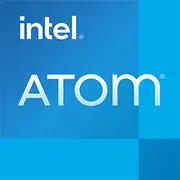Intel Atom E3826

Intel Atom E3826: A Modest Workhorse for Basic Tasks
Analyzing the Bay Trail-I processor a decade after its release
Architecture and Process Technology: Minimalism as a Philosophy
Released in 2013, the Intel Atom E3826 became part of the Bay Trail-I lineup, aimed at ultra-budget devices and embedded systems. The processor was built on a 22nm process technology, which was progressive for its time, but by 2025 appears archaic.
- Cores and Threads: 2 physical cores without Hyper-Threading support (2 threads).
- Clock Speeds: Base frequency of 1.46 GHz, with no turbo mode.
- Graphics: Integrated HD Graphics (Bay Trail) GPU with a frequency of 533 MHz and 4 execution units (EU). Supports resolutions up to 2560x1600, but is suitable only for image output, not gaming.
The Silvermont architecture underlying the E3826 is optimized for energy efficiency rather than performance. The L2 cache is a mere 1 MB, limiting data processing speed.
Power Consumption and TDP: Quiet and Cool
The processor’s TDP is 7W. This allows for a lack of active cooling, making devices based on it silent and compact. For example, mini-PCs based on the E3826 (like the ASUS VivoPC VM42) often use passive heat sinks.
However, the low TDP is achieved at the cost of modest performance. By 2025, even budget processors (like the Intel N100) with a TDP of 6-10W offer 4 cores and support for modern standards.
Performance: Only the Basics
Office Tasks:
- Using a browser with 5-7 tabs, working in Google Docs or MS Office (Word, Excel) is possible, but with delays.
- Launching Zoom or Skype will result in 100% CPU load, especially with the camera on.
Multimedia:
- Playback of 1080p video (H.264) via VLC or YouTube (with hardware acceleration) is smooth.
- 4K video or file encoding is an insurmountable task.
Gaming:
- 2010s games on low settings: Minecraft (30-40 FPS), Half-Life 2 (up to 50 FPS).
- Modern projects, even like Among Us, will experience stuttering.
Turbo Mode: Absent. Under load, the processor maintains a stable 1.46 GHz.
Use Cases: Who is the E3826 For in 2025?
1. Educational Devices: Low-cost laptops for students (like the HP Stream 11) for text work and educational applications.
2. POS Terminals and Kiosks: Low power consumption and reliability.
3. Backup Devices: As a secondary laptop for travel or checking email.
4. Mini-PCs for Digital Signage: For example, displaying information in stores.
Important! The E3826 is unsuitable for working with graphic editors, video editing, or gaming.
Battery Life: Up to Two Days in Standby
With a battery capacity of 40-45 Wh (typical for 11-inch laptops), working time reaches 8-10 hours while web surfing. However, the power-saving technologies of the E3826 are primitive:
- Intel SpeedStep: Dynamic frequency adjustment based on load.
- C-states: Putting cores into low-power mode while idle.
Compared to modern processors (like the Apple M2 with an 18-hour battery life), the E3826 falls short, but its potential can be realized in devices with 60+ Wh batteries.
Comparison with Competitors: Outdated but Alive
- AMD Athlon Silver 3050e (2020): 2 cores/2 threads, 6W TDP. 15-20% faster in multi-threaded tasks, found in devices starting from $250.
- Intel Celeron N4020 (2019): 2 cores/2 threads, 6W TDP. Supports DDR4 and has a more modern GPU.
- Apple A14 Bionic (in iPad Air): Significantly superior in energy efficiency and performance, but only within the Apple ecosystem.
The E3826 is relevant only in the segment of devices under $200, where it competes with used laptops featuring Core i3 of the 8th generation.
Pros and Cons
Strengths:
- Cost of devices: New laptops in the range of $180-$250.
- Passive cooling: No noise.
- Compatibility: Supports Windows 10/11 (with limitations), Linux.
Weaknesses:
- Low performance: Slowdowns during multitasking.
- Outdated interfaces: No USB-C, Wi-Fi 6.
- Limited support: Drivers for Windows 11 are rarely updated.
Recommendations for Choosing a Laptop
If you are considering a device with the E3826 in 2025, pay attention to:
1. Type of Storage: SSD is a must (even 64 GB is better than HDD).
2. RAM: At least 4 GB, better 8 GB (but such models are rare).
3. Screen: IPS matrix for comfortable work.
4. Ports: Availability of HDMI and USB 3.0 for peripheral connections.
A successful model example: Lenovo Ideapad Slim 110 (2024) - 11.6" IPS, 4 GB RAM, 128 GB SSD, priced at $199.
Final Conclusion: For Whom is the E3826?
This processor is a choice for those who:
- Are looking for the cheapest new device for basic tasks.
- Value silence and long battery life.
- Do not plan to use a laptop for gaming or professional tasks.
Key Benefits:
- 1-2 year warranty on new devices.
- Compatibility with lightweight OS (Chrome OS, Linux Lite).
- Ideal as a “digital notebook” for notes and reading.
However, if the budget allows for an extra $50-$100, it is better to opt for a device with an Intel N100 or AMD Athlon Silver — this will extend the “lifespan” of the purchase by 2-3 years.
Basic
CPU Specifications
Memory Specifications
GPU Specifications
Benchmarks
Compared to Other CPU
Share in social media
Or Link To Us
<a href="https://cputronic.com/cpu/intel-atom-e3826" target="_blank">Intel Atom E3826</a>